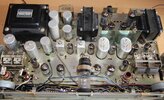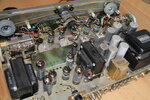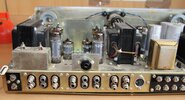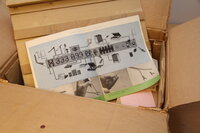-

pioneer sm-q300
 
 
  |
The
SM-Q300 model was the next in the line of stereo receivers
working in the "multicast" system. Another and the most
powerful, as the power amplifier worked on 6BQ5 / EL84
tubes in an automatic bias system. In such a system,
Pioneer used the 6AN8 as a driver tube (and not the 12AX7
/ ECC83 later in such constructions). Both the 6BQ5 and
12AX7 were made by NEC. The amplifier could be loaded with
speakers with a resistance of 4, 8 or 16 ohms.
The tuner layout was built in the same way as in the
SM-G204 model. The only difference was the dual tube
6G-E12A "magic eye" tuning indicator which replaced the
two 6E5 tubes.
The difference in the low-frequency path was the input for
a dynamic microphone, but it could work only
interchangeably with turntables.
However, there was one element that distinguished the
model from other stereo tube receivers of those years - a
quad-coupled volume potentiometer. Such solutions began to
be used in transistor designs only in the 70's, and in the
most expensive ones. In the SM-Q300, the potentiometer
regulated the input signal and the output signal of the
12AX7 / ECC83 tubes in the second stage of the band
control preamplifier. And there was one more curiosity
about this device. Triple MODE BLEND potentiometer. What
was usually done on the switches, this time Pioneer's
designers did on a potentiometer. On the front panel you
can see that in the leftmost stereo position it works
normally, in the right extreme stereo it is inverted, i.e.
the Left channel is played on the Right channel (and vice
versa). However, in the middle position, the receiver
works mono.
As a more expensive and luxurious model, the rear of the
device had a remote balance control.
The SM-Q300 looks very stylish, the silver front, pastel
frame and black plastic knobs finished with silver and
gold rings make a very nice whole.



|
Main page
Previous page
Contact
|